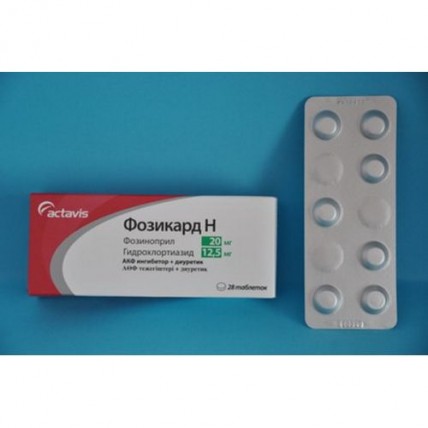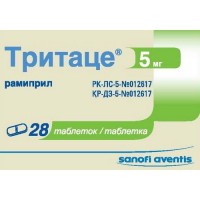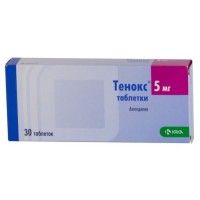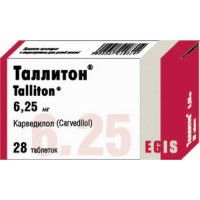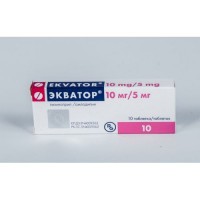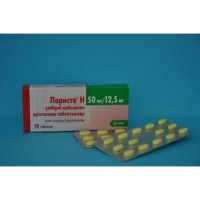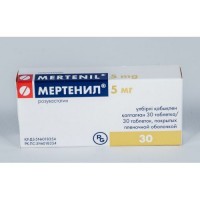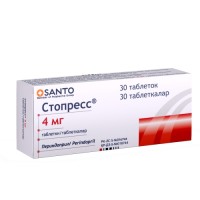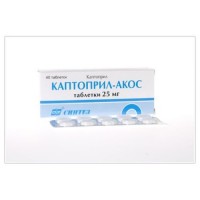The instruction for medical use
of medicine
Fosicard H
the Trade name
Fosicard H
the International unlicensed name
Is not present
the Dosage form
of the Tablet Structure One Tablet contains
active agents: sodium
Hydrochlorthiazidum of 12.5 mg,
excipients fozinoprit 20 mg: lactoses monohydrate, starch prezhelatinizirovanny (starch 1500), sodium of a kroskarmeloz, lactose monohydrate (Tablettoza 80), glitserola dibekhenat, mix of pigments RV-23601: titan dioxide, lactoses monohydrate, ferrous oxide yellow, ferrous oxide red.
The description
of the Tablet of round shape, with a flat surface, light orange color, with the inscription FH on one party, with a diameter about 9 mm.
Pharmacotherapeutic group
the Drugs influencing a system renin-angiotensin. AKF inhibitors in a combination with diuretics. Fozinopril in a combination with diuretics
the ATX C09BA09 Code
the Pharmacological
Pharmacokinetics Pharmacokinetics properties of a fozinopril and Hydrochlorthiazidum at a concomitant use does not differ from that at their separate appointment. After intake the absorption of a fozinopril is about 30-40%, from them only 50-100% are hydrolyzed in a liver to the fozinoprilat. Extent of absorption of a fozinopril does not depend on meal, but the speed of absorption can be slowed down. At the broken function of a liver the speed of hydrolysis can be slowed down, at the same time extent of hydrolysis considerably does not change.
The maximum concentration of the fozinoprilat in blood plasma is reached approximately in 3 hours and does not depend on the accepted dose of a fozinopril. Fozinopril possesses linear pharmacokinetics. Fozinoprilat highly contacts proteins of blood plasma (90-95%) and in insignificant degree contacts cellular components of blood. Has rather small volume of distribution. At patients with arterial hypertension at normal function of kidneys and a liver the elimination half-life of the fozinoprilat makes about 11.5 hours.
After intake the absorption of Hydrochlorthiazidum is 60-80%. The maximum concentration of Hydrochlorthiazidum in blood is reached in 1-5 hours after intake. Linking with proteins of plasma makes 64%. Hydrochlorthiazidum is not metabolized and quickly removed through kidneys. Elimination half-life makes 5-15 hours.
The renal failure
In a renal failure absorption, bioavailability and linking of drug with proteins of blood plasma significantly does not change. The general clearance of the fozinoprilat at patients with a renal failure is nearly 50% lower, than at patients with normal function of kidneys. As removal through a liver with bile partially compensates decrease in removal through kidneys, the clearance of the fozinoprilat significantly does not differ at patients with average degree of a renal failure from that at patients with heavy degree of a renal failure. At patients with a renal failure of various degree, including a renal failure in an end-stage (clearance of creatinine less than 10 ml/min.), moderate increase in an indicator the area under a curve concentration – time is noted (AUC) (less than twice in comparison with that at patients with normal function of kidneys). The clearance of the fozinoprilat at a hemodialysis and peritoneal dialysis averages 2% and 7% in comparison with clearance of urea.
The liver failure
Extent of hydrolysis of the fozinoprilat at patients with alcoholic or biliary cirrhosis decreases in insignificant degree in spite of the fact that the speed of hydrolysis can be reduced. The maximum concentration and an indicator of the AUC fozinoprilat above at patients with a renal failure after reception of the first dose, however, at introduction of repeated doses this difference has no clinical value.
The pharmacodynamics
Fosicard H renders hypotensive, vazodilatiruyushchy, diuretic and kaliysberegayushchy action. Reduces the general peripheric resistance and system arterial blood pressure. Drug suppresses synthesis of Aldosteronum, inhibits fabric AKF (angiotensin - the converting enzymes).
Increases activity of renin of blood plasma, secretion of Aldosteronum and reduces concentration of potassium ions in blood serum.
After intake the decrease in the ABP begins in 1 hour, reaches the maximum values in 2-6 hours. Decrease in indicators of the ABP in 24 hours is 60-90% of the maximum decrease in the ABP that allows to take the drug of 1 times a day.
Indications
- arterial hypertension
the Route of administration and doses
Inside, in the mornings, irrespective of meal time, washing down with enough liquid. The dosage has to be selected individually.
A usual dose – 1 tablet of 1 times a day.
Duration of treatment is defined by the attending physician.
Patients with a moderate renal failure (clearance of creatinine & gt, 30 ml/min. and & lt, 80 ml/min.) should carry out dose adjustment with exclusive care by gradual selection.
Side effects
Very often (≥10%)
- a hyperglycemia, a glucosuria, a hyperuricemia, an electrolytic imbalance (including a hyponatremia), increase in level of cholesterol and triglycerides
is frequent (≥1% - & lt, 10%)
- dizziness, a headache
- tachycardia, heartbeat
- hypotonia, orthostatic hypotension
- cough
- nausea, irritation of a stomach, vomiting, diarrhea, a constipation, pancreatitis
- rash, a Quincke's disease, dermatitis
- a stethalgia, weakness
- increase in level of alkaline phosphatase, bilirubin, LDG and transaminases
- reversible increase in level of creatinine, urea, uric acid
Infrequently (≥0.1% - & lt, 1%)
- reversible decrease in level of a gemoglibin and a hematocrit
- gout, a hyperpotassemia
- a depression, confusion of consciousness
- a cerebral heart attack, paresthesia, drowsiness, a stroke, a syncope, disturbances of taste, a sleep disorder
- disorders of vision, a xanthopsia
- ear pain, a ring in ears
- stenocardia, a myocardial infarction and an acute disorder of cerebral circulation, cardiac arrest, disturbance of a rhythm, disturbance of conductivity
- hypertensia, shock, passing ischemia
- dispnoe, rhinitis, sinusitis, a tracheobronchitis
- dryness in a mouth, a meteorism
- a hyperhidrosis, an itching, urticaria, reactions of photosensitivity
- myalgia
- a renal failure, interstitial nephrite, disturbance of sexual function
- fever, peripheral hypostasis, sudden death, a stethalgia
- increase in weight
- a loss of appetite, anorexia
- a respiratory distress syndrome (including a pneumonitis and a fluid lungs)
- intra hepatic cholestatic jaundice
Seldom (≥0.01% - & lt, 0.1%)
- reversible anemia, an eosinophilia, a leukopenia, a lymphadenopathy, a neutropenia
- a dysphasia, memory disturbance, a disorientation
- inflows, a hemorrhage, a disease of peripheral vessels
- a bronchospasm, nasal bleeding, laryngitis/hoarseness, pneumonia, pulmonary hyperaemia
- an ulceration of an oral cavity, pancreatitis, swelling of language, an abdominal distension, a dysphagy, hepatitis
- an ecchymoma
- arthritis
- dysfunctions of a prostate
- weakness in extremities
- a hyponatremia, increase in level of hemoglobin
- a sialadenitis
- a leukopenia, a neutropenia/agranulocytosis, thrombocytopenia, aplastic anemia, hemolytic anemia, suppression of activity of marrow
- uneasiness, a sleep disorder, a depression
- a vasculitis
- skin volchanochnopodobny reactions, reactivation of a skin lupus erythematosus, anaphylactic reactions, a toxic epidermal necrolysis
- a muscular spasm
- a renal failure
is Very rare (≥0.01% - & lt, 0.1%)
- an agranulocytosis
- a Quincke's disease, (partial) intestinal impassability
- a liver failure
- an acute renal failure
of the Contraindication
- hypersensitivity to components of drug or
AKF inhibitors and to sulfonamide derivatives, including tiazida
- a hereditary or idiopathic Quincke's disease, including
in the anamnesis, after intake of other AKF inhibitors
- a heavy renal failure (clearance of creatinine & lt, 30 ml/min.)
- the patients who are on a hemodialysis
- a renal artery stenosis (bilateral or unilateral at patients with
one kidney)
- a state after transplantation of a kidney
- hemodynamically significant stenosis of the aortal or mitral valve
or a hypertrophic cardiomyopathy
- primary hyper aldosteronism
- a heavy liver failure (precoma /
a hepatic coma)
- clinically significant disturbances of electrolytic balance
(hypercalcemia, a hyponatremia, a hypopotassemia)
- severe forms of diabetes
- dekompensirovanny heart failure
- an anury
- gout
- pregnancy, the lactation period
- children's and teenage age up to 18 years
Medicinal interactions
Antihypertensives, diuretics, narcotic analgetics, means for the general anesthesia strengthen hypotensive effect of Fosicard H.
Potassium drugs, kaliysberegayushchy diuretics (Spironolactonum, amiloride, Triamterenum) increase risk of development of a hyperpotassemia. Control of level of potassium in blood serum is necessary (1 time in 2-3 weeks).
At a concomitant use with salts of lithium the increase in concentration of lithium in blood and risk of development of lithium toxicity is possible.
Drug enhances hypoglycemic effect of derivatives of sulphonylurea, insulin, risk of development of a leukopenia at simultaneous use with Allopyrinolum, cytostatic medicines, immunodepressants, procaineamide.
Non-steroidal anti-inflammatory drugs and estrogen reduce expressiveness of hypotensive effect.
Drugs for treatment of gout. Increase in doses of a probenetsid or Sulfinpyrazonum applied to treatment of gout as Hydrochlorthiazidum can increase concentration of uric acid in blood can be required.
Alcohol, barbiturates and narcotic analgetics can reduce hypotensive effect of drug.
Digitalis glycosides increase risk of digitalis intoxication in connection with the hypopotassemia caused tiazidy.
Holestiramin and kolestipol can reduce Hydrochlorthiazidum absorption. Fosicard H should be accepted, at least, in 1 hour prior to or in 4-6 hours after reception of the specified means.
Calcium salts. Hydrochlorthiazidum can increase concentration of calcium ions in blood serum due to reduction of removal it from an organism. At simultaneous use with Fosicard H the reduction of a dose of drugs of calcium can be required.
The bioavailability of drug at simultaneous use with Chlortalidonum, nifedipine, propranolol, Cimetidinum, Metoclopramidum, a propantelina bromide, digoxin, acetylsalicylic acid and warfarin does not change. Absorption of Hydrochlorthiazidum increases at a concomitant use of the means reducing motility of digestive tract.
Antacids (aluminum or magnesium hydroxide, simetikon and others) can reduce absorbability of Fosicard H. It is necessary to accept the specified means with an interval not less than 2 hours.
The special
instructions Begin Therapy Fosicard H follows from correction of water and electrolytic balance. Fozinopril can cause symptomatic arterial hypotension that most likely at patients with a reduced volume of the circulating blood as a result of the long-term previous treatment by diuretics, restrictions of intake of salt in an organism, dialysis, diarrhea or vomiting.
Arterial hypotension is not an absolute contraindication for further use of Fosicard H. The maximum decrease in the ABP is noted at early stages of treatment and is stabilized usually on the 2nd week of therapy. At further use of drug of decrease in its therapeutic effectiveness it is not observed.
At use of AKF inhibitors, including fozinoprit, the Quincke's disease can develop. In hypostasis of language, a throat, throat the obstruction of airways can develop. Patients have to stop administration of drug and immediately report to the attending physician about appearance of hypostases on a face, eyes, lips and language, about a spasm of muscles of a throat or the complicated breath. In such cases fast taking measures of emergency aid is necessary. It is also necessary to be careful at treatment of sick AKF during procedures of desensitization.
During a hemodialysis through high-permeability membranes and also during an aferez of lipoproteins of low density with adsorption on a dextran sulfate there can be anaphylactic reactions. In these cases it is necessary to use dialysis membranes of other type or other drug treatment.
At patients with a renal failure, especially in the presence of general diseases of connective tissue, the agranulocytosis and suppression of function of marrow can develop. In this case it is necessary to watch the content of white blood cells at such patients. Such patients should be warned about need to report about emergence of any symptoms of an infection – fever, a sore throat, etc.
It is necessary to be careful when prescribing drug the patient with a heavy renal failure. At patients with arterial hypertension with a renal artery stenosis of one or both kidneys and also at simultaneous use of diuretics during treatment by AKF inhibitors, the level of urea nitrogen of blood and creatinine of blood serum can increase. These effects are reversible and pass after the treatment termination. At such patients it is necessary to monitor function of kidneys within the 2 first weeks of treatment. The drug dose decline can be required.
With heavy heart failure, an oliguria and/or the progressing azotemia at existence or absence of a renal failure the treatment with AKF inhibitors can cause excess hypotensive effect which can strengthen an oliguria or an azotemia in patients, and in rare instances – to lead to a lethal outcome. Therefore at such patients the drug treatment should be begun with the minimum therapeutic doses and under stringent control of the ABP, especially for the first 2 weeks of treatment.
Hydrochlorthiazidum can cause a hypopotassemia, a hyponatremia and a gipokhloremichesky alkalosis. In the presence of a fozinopril of sodium the risk of a hypopotassemia decreases. Hydrochlorthiazidum promotes decrease in removal of calcium ions from an organism, increase in removal of ions of magnesium with urine that can lead to a hypomagnesiemia. Periodic control of concentration of electrolytes in blood serum is necessary.
Concentration of uric acid in blood can increase, and at some patients accepting thiazide diuretics the bad attack of gout can develop.
At patients with diabetes the need for insulin can change, latent forms of diabetes can get a manifest form against the background of use of tiazid. Increase in concentration of triglycerides and cholesterol is connected with treatment by thiazide diuretics.
The cough caused by AKF inhibitors, including fozinoprit, usually has unproductive and persistent character, and passes after the termination of administration of drugs. The cough caused by AKF inhibitors has to be considered as one of options at differential diagnosis of cough.
In rare instances use of AKF inhibitors can lead to appearance of cholestatic jaundice with development of lightning necrosis of hepatocytes.
Elderly patients can be more sensitive to effect of drug owing to the slowed-down metabolism.
The feature of influence on ability to run the vehicle or potentially dangerous mechanisms
needs to be careful at control of vehicles or when performing any work requiring special attention because of possible appearance of dizziness, especially after an initial dose of drug.
Overdose
Symptoms: significant decrease in the ABP, bradycardia, shock, disturbance of water and electrolytic balance, acute renal failure, stupor.
Treatment: to stop administration of drug, to lay the patient in horizontal position with the raised legs. In mild cases of overdose – gastric lavage, introduction of sorbents and sodium of sulfate within 30 minutes after reception. At decrease in the ABP – intravenous administration of catecholamines, angiotensin II, in bradycardia – use of the pacemaker. The hemodialysis is inefficient.
A form of release and packing
On 7 or 10 tablets in perforated blister strip packaging from a film polyvinylchloride with a covering from aluminum foil from the inside and aluminum foil.
On 2 or 4 blister strip packagings on 7 tablets, or on the 3rd blister strip packagings on 10 tablets together with the instruction for medical use in the state and Russian languages place in a pack from cardboard.
To Store storage conditions at a temperature not above 25 °C.
To store out of children's reach!
A period of storage
3 years
it is impossible to use Drug after the expiration date specified on packing.
Prescription status
According to the prescription
Balkanfarma-Dupnitsa Producer of the ABP, Bulgaria
the Owner of the registration certificate
of Aktavis Group, Iceland
the Address of the organization accepting in the territory of the Republic of Kazakhstan claims on quality of products from consumers
of Predstavitelstvo Aktavis International Ltd in
Almaty Republic of Kazakhstan, 050009, Almaty, Mukanov St., 241-1A.
Ph./fax: 8 (727) 313 74 30, 313 74 31,
E-mail address: actavis@actavis.kz, website:
To Develop www.actavis.com
of medicine
Fosicard H
the Trade name
Fosicard H
the International unlicensed name
Is not present
the Dosage form
of the Tablet Structure One Tablet contains
active agents: sodium
Hydrochlorthiazidum of 12.5 mg,
excipients fozinoprit 20 mg: lactoses monohydrate, starch prezhelatinizirovanny (starch 1500), sodium of a kroskarmeloz, lactose monohydrate (Tablettoza 80), glitserola dibekhenat, mix of pigments RV-23601: titan dioxide, lactoses monohydrate, ferrous oxide yellow, ferrous oxide red.
The description
of the Tablet of round shape, with a flat surface, light orange color, with the inscription FH on one party, with a diameter about 9 mm.
Pharmacotherapeutic group
the Drugs influencing a system renin-angiotensin. AKF inhibitors in a combination with diuretics. Fozinopril in a combination with diuretics
the ATX C09BA09 Code
the Pharmacological
Pharmacokinetics Pharmacokinetics properties of a fozinopril and Hydrochlorthiazidum at a concomitant use does not differ from that at their separate appointment. After intake the absorption of a fozinopril is about 30-40%, from them only 50-100% are hydrolyzed in a liver to the fozinoprilat. Extent of absorption of a fozinopril does not depend on meal, but the speed of absorption can be slowed down. At the broken function of a liver the speed of hydrolysis can be slowed down, at the same time extent of hydrolysis considerably does not change.
The maximum concentration of the fozinoprilat in blood plasma is reached approximately in 3 hours and does not depend on the accepted dose of a fozinopril. Fozinopril possesses linear pharmacokinetics. Fozinoprilat highly contacts proteins of blood plasma (90-95%) and in insignificant degree contacts cellular components of blood. Has rather small volume of distribution. At patients with arterial hypertension at normal function of kidneys and a liver the elimination half-life of the fozinoprilat makes about 11.5 hours.
After intake the absorption of Hydrochlorthiazidum is 60-80%. The maximum concentration of Hydrochlorthiazidum in blood is reached in 1-5 hours after intake. Linking with proteins of plasma makes 64%. Hydrochlorthiazidum is not metabolized and quickly removed through kidneys. Elimination half-life makes 5-15 hours.
The renal failure
In a renal failure absorption, bioavailability and linking of drug with proteins of blood plasma significantly does not change. The general clearance of the fozinoprilat at patients with a renal failure is nearly 50% lower, than at patients with normal function of kidneys. As removal through a liver with bile partially compensates decrease in removal through kidneys, the clearance of the fozinoprilat significantly does not differ at patients with average degree of a renal failure from that at patients with heavy degree of a renal failure. At patients with a renal failure of various degree, including a renal failure in an end-stage (clearance of creatinine less than 10 ml/min.), moderate increase in an indicator the area under a curve concentration – time is noted (AUC) (less than twice in comparison with that at patients with normal function of kidneys). The clearance of the fozinoprilat at a hemodialysis and peritoneal dialysis averages 2% and 7% in comparison with clearance of urea.
The liver failure
Extent of hydrolysis of the fozinoprilat at patients with alcoholic or biliary cirrhosis decreases in insignificant degree in spite of the fact that the speed of hydrolysis can be reduced. The maximum concentration and an indicator of the AUC fozinoprilat above at patients with a renal failure after reception of the first dose, however, at introduction of repeated doses this difference has no clinical value.
The pharmacodynamics
Fosicard H renders hypotensive, vazodilatiruyushchy, diuretic and kaliysberegayushchy action. Reduces the general peripheric resistance and system arterial blood pressure. Drug suppresses synthesis of Aldosteronum, inhibits fabric AKF (angiotensin - the converting enzymes).
Increases activity of renin of blood plasma, secretion of Aldosteronum and reduces concentration of potassium ions in blood serum.
After intake the decrease in the ABP begins in 1 hour, reaches the maximum values in 2-6 hours. Decrease in indicators of the ABP in 24 hours is 60-90% of the maximum decrease in the ABP that allows to take the drug of 1 times a day.
Indications
- arterial hypertension
the Route of administration and doses
Inside, in the mornings, irrespective of meal time, washing down with enough liquid. The dosage has to be selected individually.
A usual dose – 1 tablet of 1 times a day.
Duration of treatment is defined by the attending physician.
Patients with a moderate renal failure (clearance of creatinine & gt, 30 ml/min. and & lt, 80 ml/min.) should carry out dose adjustment with exclusive care by gradual selection.
Side effects
Very often (≥10%)
- a hyperglycemia, a glucosuria, a hyperuricemia, an electrolytic imbalance (including a hyponatremia), increase in level of cholesterol and triglycerides
is frequent (≥1% - & lt, 10%)
- dizziness, a headache
- tachycardia, heartbeat
- hypotonia, orthostatic hypotension
- cough
- nausea, irritation of a stomach, vomiting, diarrhea, a constipation, pancreatitis
- rash, a Quincke's disease, dermatitis
- a stethalgia, weakness
- increase in level of alkaline phosphatase, bilirubin, LDG and transaminases
- reversible increase in level of creatinine, urea, uric acid
Infrequently (≥0.1% - & lt, 1%)
- reversible decrease in level of a gemoglibin and a hematocrit
- gout, a hyperpotassemia
- a depression, confusion of consciousness
- a cerebral heart attack, paresthesia, drowsiness, a stroke, a syncope, disturbances of taste, a sleep disorder
- disorders of vision, a xanthopsia
- ear pain, a ring in ears
- stenocardia, a myocardial infarction and an acute disorder of cerebral circulation, cardiac arrest, disturbance of a rhythm, disturbance of conductivity
- hypertensia, shock, passing ischemia
- dispnoe, rhinitis, sinusitis, a tracheobronchitis
- dryness in a mouth, a meteorism
- a hyperhidrosis, an itching, urticaria, reactions of photosensitivity
- myalgia
- a renal failure, interstitial nephrite, disturbance of sexual function
- fever, peripheral hypostasis, sudden death, a stethalgia
- increase in weight
- a loss of appetite, anorexia
- a respiratory distress syndrome (including a pneumonitis and a fluid lungs)
- intra hepatic cholestatic jaundice
Seldom (≥0.01% - & lt, 0.1%)
- reversible anemia, an eosinophilia, a leukopenia, a lymphadenopathy, a neutropenia
- a dysphasia, memory disturbance, a disorientation
- inflows, a hemorrhage, a disease of peripheral vessels
- a bronchospasm, nasal bleeding, laryngitis/hoarseness, pneumonia, pulmonary hyperaemia
- an ulceration of an oral cavity, pancreatitis, swelling of language, an abdominal distension, a dysphagy, hepatitis
- an ecchymoma
- arthritis
- dysfunctions of a prostate
- weakness in extremities
- a hyponatremia, increase in level of hemoglobin
- a sialadenitis
- a leukopenia, a neutropenia/agranulocytosis, thrombocytopenia, aplastic anemia, hemolytic anemia, suppression of activity of marrow
- uneasiness, a sleep disorder, a depression
- a vasculitis
- skin volchanochnopodobny reactions, reactivation of a skin lupus erythematosus, anaphylactic reactions, a toxic epidermal necrolysis
- a muscular spasm
- a renal failure
is Very rare (≥0.01% - & lt, 0.1%)
- an agranulocytosis
- a Quincke's disease, (partial) intestinal impassability
- a liver failure
- an acute renal failure
of the Contraindication
- hypersensitivity to components of drug or
AKF inhibitors and to sulfonamide derivatives, including tiazida
- a hereditary or idiopathic Quincke's disease, including
in the anamnesis, after intake of other AKF inhibitors
- a heavy renal failure (clearance of creatinine & lt, 30 ml/min.)
- the patients who are on a hemodialysis
- a renal artery stenosis (bilateral or unilateral at patients with
one kidney)
- a state after transplantation of a kidney
- hemodynamically significant stenosis of the aortal or mitral valve
or a hypertrophic cardiomyopathy
- primary hyper aldosteronism
- a heavy liver failure (precoma /
a hepatic coma)
- clinically significant disturbances of electrolytic balance
(hypercalcemia, a hyponatremia, a hypopotassemia)
- severe forms of diabetes
- dekompensirovanny heart failure
- an anury
- gout
- pregnancy, the lactation period
- children's and teenage age up to 18 years
Medicinal interactions
Antihypertensives, diuretics, narcotic analgetics, means for the general anesthesia strengthen hypotensive effect of Fosicard H.
Potassium drugs, kaliysberegayushchy diuretics (Spironolactonum, amiloride, Triamterenum) increase risk of development of a hyperpotassemia. Control of level of potassium in blood serum is necessary (1 time in 2-3 weeks).
At a concomitant use with salts of lithium the increase in concentration of lithium in blood and risk of development of lithium toxicity is possible.
Drug enhances hypoglycemic effect of derivatives of sulphonylurea, insulin, risk of development of a leukopenia at simultaneous use with Allopyrinolum, cytostatic medicines, immunodepressants, procaineamide.
Non-steroidal anti-inflammatory drugs and estrogen reduce expressiveness of hypotensive effect.
Drugs for treatment of gout. Increase in doses of a probenetsid or Sulfinpyrazonum applied to treatment of gout as Hydrochlorthiazidum can increase concentration of uric acid in blood can be required.
Alcohol, barbiturates and narcotic analgetics can reduce hypotensive effect of drug.
Digitalis glycosides increase risk of digitalis intoxication in connection with the hypopotassemia caused tiazidy.
Holestiramin and kolestipol can reduce Hydrochlorthiazidum absorption. Fosicard H should be accepted, at least, in 1 hour prior to or in 4-6 hours after reception of the specified means.
Calcium salts. Hydrochlorthiazidum can increase concentration of calcium ions in blood serum due to reduction of removal it from an organism. At simultaneous use with Fosicard H the reduction of a dose of drugs of calcium can be required.
The bioavailability of drug at simultaneous use with Chlortalidonum, nifedipine, propranolol, Cimetidinum, Metoclopramidum, a propantelina bromide, digoxin, acetylsalicylic acid and warfarin does not change. Absorption of Hydrochlorthiazidum increases at a concomitant use of the means reducing motility of digestive tract.
Antacids (aluminum or magnesium hydroxide, simetikon and others) can reduce absorbability of Fosicard H. It is necessary to accept the specified means with an interval not less than 2 hours.
The special
instructions Begin Therapy Fosicard H follows from correction of water and electrolytic balance. Fozinopril can cause symptomatic arterial hypotension that most likely at patients with a reduced volume of the circulating blood as a result of the long-term previous treatment by diuretics, restrictions of intake of salt in an organism, dialysis, diarrhea or vomiting.
Arterial hypotension is not an absolute contraindication for further use of Fosicard H. The maximum decrease in the ABP is noted at early stages of treatment and is stabilized usually on the 2nd week of therapy. At further use of drug of decrease in its therapeutic effectiveness it is not observed.
At use of AKF inhibitors, including fozinoprit, the Quincke's disease can develop. In hypostasis of language, a throat, throat the obstruction of airways can develop. Patients have to stop administration of drug and immediately report to the attending physician about appearance of hypostases on a face, eyes, lips and language, about a spasm of muscles of a throat or the complicated breath. In such cases fast taking measures of emergency aid is necessary. It is also necessary to be careful at treatment of sick AKF during procedures of desensitization.
During a hemodialysis through high-permeability membranes and also during an aferez of lipoproteins of low density with adsorption on a dextran sulfate there can be anaphylactic reactions. In these cases it is necessary to use dialysis membranes of other type or other drug treatment.
At patients with a renal failure, especially in the presence of general diseases of connective tissue, the agranulocytosis and suppression of function of marrow can develop. In this case it is necessary to watch the content of white blood cells at such patients. Such patients should be warned about need to report about emergence of any symptoms of an infection – fever, a sore throat, etc.
It is necessary to be careful when prescribing drug the patient with a heavy renal failure. At patients with arterial hypertension with a renal artery stenosis of one or both kidneys and also at simultaneous use of diuretics during treatment by AKF inhibitors, the level of urea nitrogen of blood and creatinine of blood serum can increase. These effects are reversible and pass after the treatment termination. At such patients it is necessary to monitor function of kidneys within the 2 first weeks of treatment. The drug dose decline can be required.
With heavy heart failure, an oliguria and/or the progressing azotemia at existence or absence of a renal failure the treatment with AKF inhibitors can cause excess hypotensive effect which can strengthen an oliguria or an azotemia in patients, and in rare instances – to lead to a lethal outcome. Therefore at such patients the drug treatment should be begun with the minimum therapeutic doses and under stringent control of the ABP, especially for the first 2 weeks of treatment.
Hydrochlorthiazidum can cause a hypopotassemia, a hyponatremia and a gipokhloremichesky alkalosis. In the presence of a fozinopril of sodium the risk of a hypopotassemia decreases. Hydrochlorthiazidum promotes decrease in removal of calcium ions from an organism, increase in removal of ions of magnesium with urine that can lead to a hypomagnesiemia. Periodic control of concentration of electrolytes in blood serum is necessary.
Concentration of uric acid in blood can increase, and at some patients accepting thiazide diuretics the bad attack of gout can develop.
At patients with diabetes the need for insulin can change, latent forms of diabetes can get a manifest form against the background of use of tiazid. Increase in concentration of triglycerides and cholesterol is connected with treatment by thiazide diuretics.
The cough caused by AKF inhibitors, including fozinoprit, usually has unproductive and persistent character, and passes after the termination of administration of drugs. The cough caused by AKF inhibitors has to be considered as one of options at differential diagnosis of cough.
In rare instances use of AKF inhibitors can lead to appearance of cholestatic jaundice with development of lightning necrosis of hepatocytes.
Elderly patients can be more sensitive to effect of drug owing to the slowed-down metabolism.
The feature of influence on ability to run the vehicle or potentially dangerous mechanisms
needs to be careful at control of vehicles or when performing any work requiring special attention because of possible appearance of dizziness, especially after an initial dose of drug.
Overdose
Symptoms: significant decrease in the ABP, bradycardia, shock, disturbance of water and electrolytic balance, acute renal failure, stupor.
Treatment: to stop administration of drug, to lay the patient in horizontal position with the raised legs. In mild cases of overdose – gastric lavage, introduction of sorbents and sodium of sulfate within 30 minutes after reception. At decrease in the ABP – intravenous administration of catecholamines, angiotensin II, in bradycardia – use of the pacemaker. The hemodialysis is inefficient.
A form of release and packing
On 7 or 10 tablets in perforated blister strip packaging from a film polyvinylchloride with a covering from aluminum foil from the inside and aluminum foil.
On 2 or 4 blister strip packagings on 7 tablets, or on the 3rd blister strip packagings on 10 tablets together with the instruction for medical use in the state and Russian languages place in a pack from cardboard.
To Store storage conditions at a temperature not above 25 °C.
To store out of children's reach!
A period of storage
3 years
it is impossible to use Drug after the expiration date specified on packing.
Prescription status
According to the prescription
Balkanfarma-Dupnitsa Producer of the ABP, Bulgaria
the Owner of the registration certificate
of Aktavis Group, Iceland
the Address of the organization accepting in the territory of the Republic of Kazakhstan claims on quality of products from consumers
of Predstavitelstvo Aktavis International Ltd in
Almaty Republic of Kazakhstan, 050009, Almaty, Mukanov St., 241-1A.
Ph./fax: 8 (727) 313 74 30, 313 74 31,
E-mail address: actavis@actavis.kz, website:
To Develop www.actavis.com
